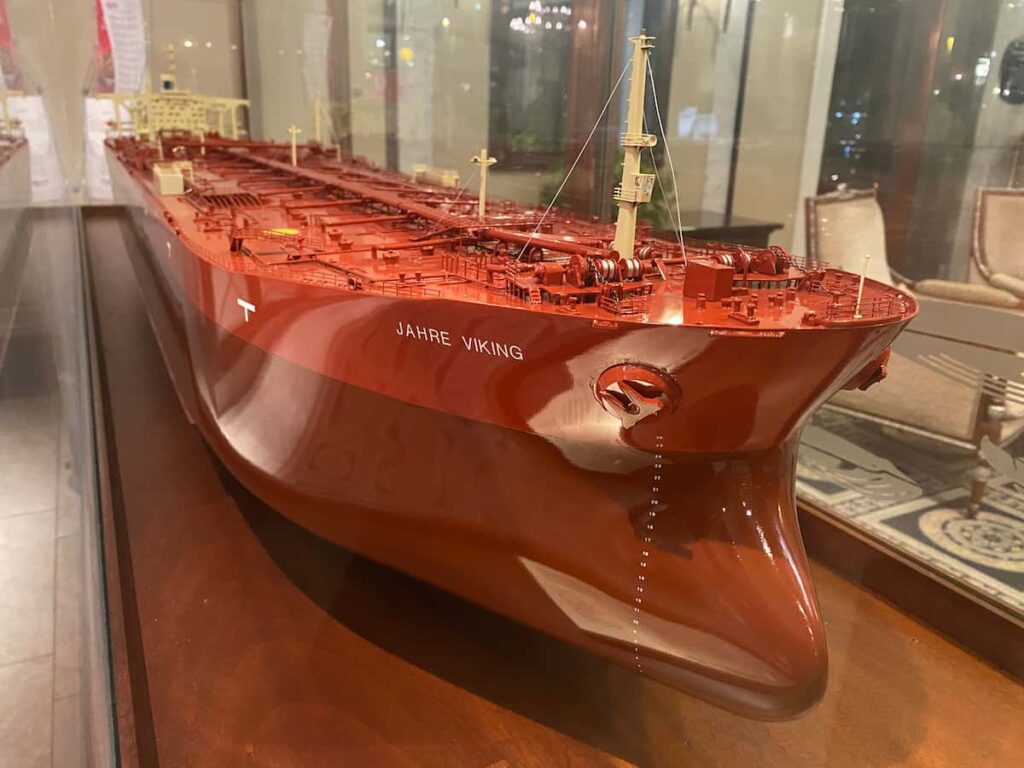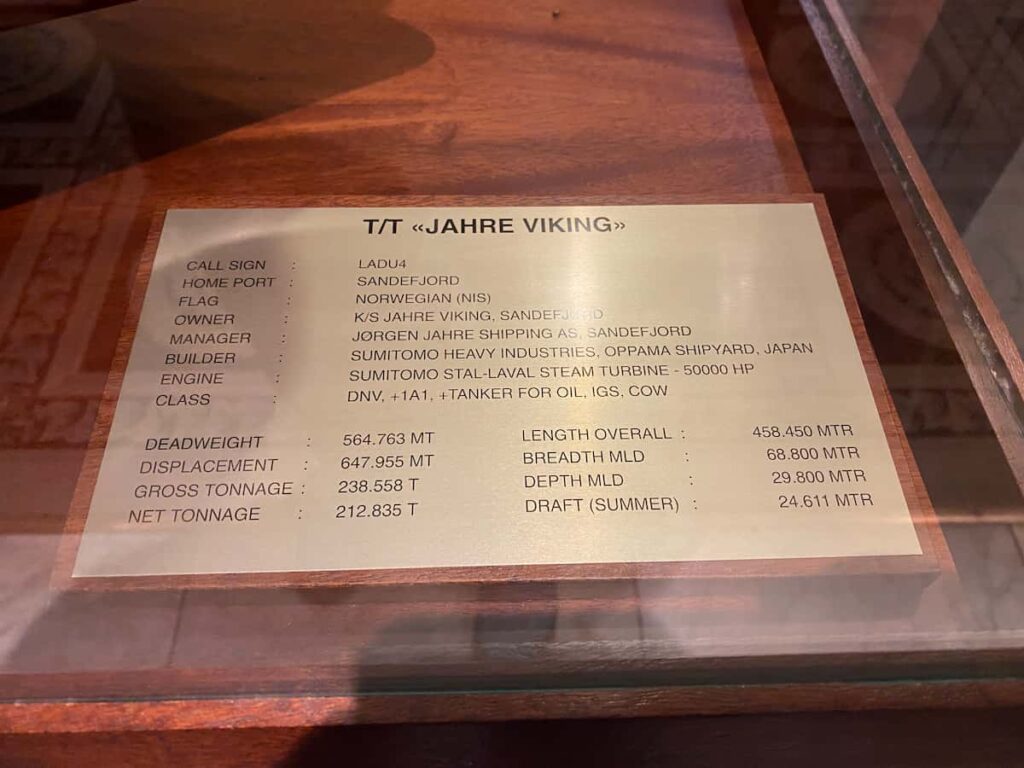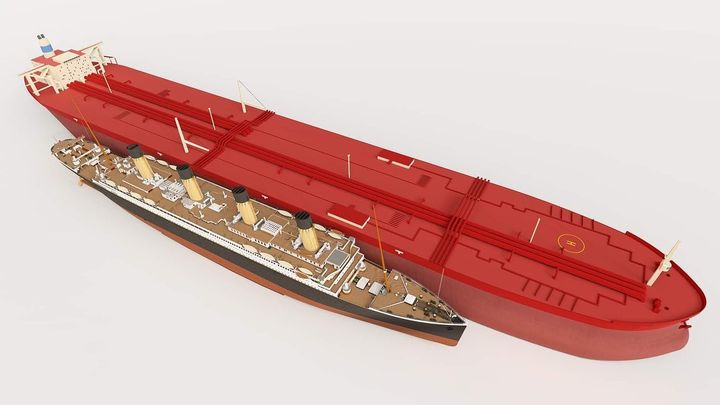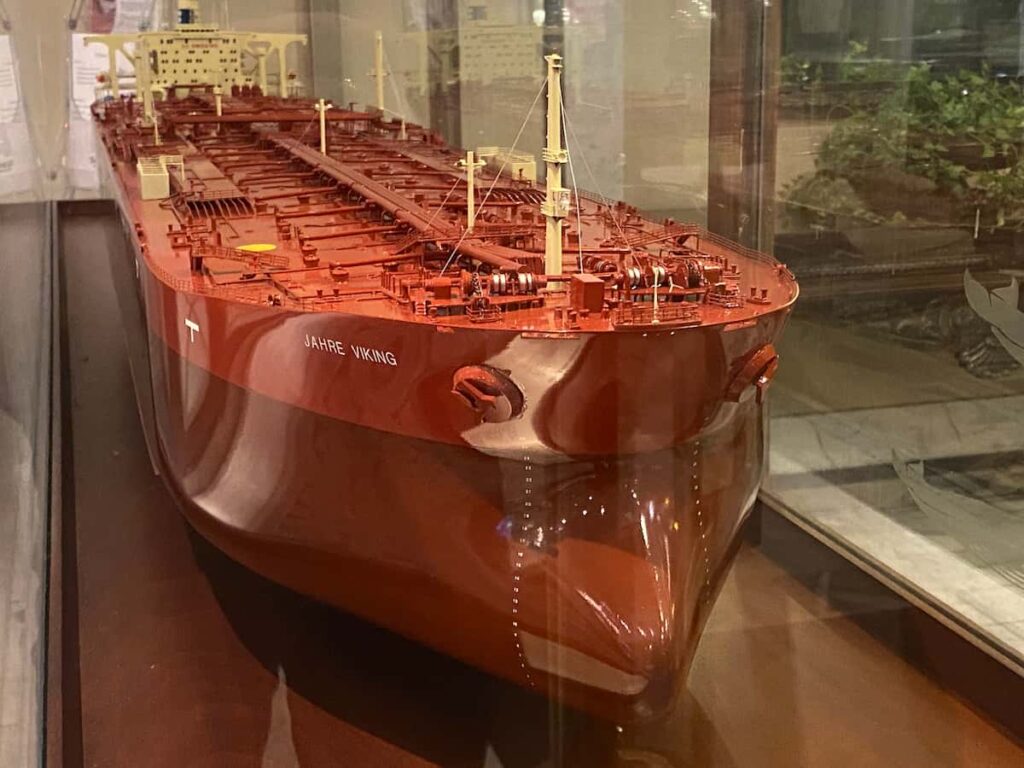The Seawise Giant, also known as Knock Nevis, was the largest ship ever built in human history. It was an ultra-large crude carrier (ULCC) that was built by Sumitomo Heavy Industries in Yokosuka, Kanagawa, Japan from 1974 to 1979. The ship was launched in 1979 and it possessed the greatest deadweight tonnage ever recorded. Fully laden, its displacement was 657,019 tonnes, and it was nearly twice as long as the Titanic.
Throughout its long and turbulent history, the Seawise Giant would be known by several names, including Oppama, Happy Giant, Jahre Viking, and Mont. It was designed to transport crude oil on one of the major maritime trade routes from the Middle East to the United States and Europe.

The ship was so large that it had a two-mile turning circle and it took her more than 5 miles to stop. The ship was so big that it could not navigate through the English Channel, Panama Canal, or Suez Canal. It had to travel around the southern tip of Africa to reach its destination.
The Seawise Giant had a length of 458.45 meters, a beam of 68.8 meters, and a depth of 29.8 meters. It was powered by eight diesel engines and it had a maximum speed of 16 knots. The ship could carry up to 4.1 million barrels of crude oil.
The Seawise Giant was so large that it was considered too expensive and impractical to operate, and it was eventually sold for scrap in 2010. Despite its short lifespan, the Seawise Giant remains a marvel of engineering and a testament to human ingenuity.
Seawise Giant
Seawise Giant, also known as Knock Nevis, was a ULCC supertanker that was the longest self-propelled ship in history. Built in 1974-1979 by Sumitomo Heavy Industries in Yokosuka, Kanagawa, Japan, she possessed the greatest deadweight tonnage ever recorded. Throughout her long and turbulent history, she would be known by several names: Oppama, Happy Giant, Jahre Viking, and Mont.
History of The Largest Ship Ever Built
Seawise Giant was built in Japan by Sumitomo Heavy Industries for the Greek shipping magnate Stavros Niarchos. She was launched in 1979 and was the largest ship ever built at the time. She was originally named Oppama, but was later renamed Happy Giant, Jahre Viking, Knock Nevis, and Mont.
Throughout her career, Seawise Giant was used primarily to transport crude oil from the Middle East to the United States. However, she was also used to transport other types of cargo, including iron ore and grain.

Specifications of The Largest Ship Ever Built
Seawise Giant was an ultra-large crude carrier (ULCC) that was 458.45 meters (1,503.0 feet) long and 68.8 meters (225.7 feet) wide. She had a draft of 24.611 meters (80.74 feet) when fully loaded and a displacement of 657,019 tonnes (646,642 long tons; 724,239 short tons). She could carry up to 4.1 million barrels of oil.

Seawise Giant was powered by eight diesel engines that produced a total of 110,000 horsepower. She had a top speed of 16 knots (30 km/h; 18 mph) and a range of 20,000 nautical miles (37,000 km; 23,000 mi).
Accidents
Seawise Giant had a turbulent history that included several accidents. In 1988, she was damaged by a missile attack during the Iran-Iraq War. She was repaired and returned to service, but was eventually sold to Norwegian shipping company Jorgen Jahre in 1991 and renamed Jahre Viking.
In 2004, Jahre Viking was damaged by a collision with a pier in Taiwan. She was repaired and renamed Knock Nevis, and was used as a floating storage and offloading unit (FSO) in the Persian Gulf.
In 2010, Knock Nevis was beached in Alang, India, and was dismantled for scrap. Her record as the largest ship ever built still stands.

Knock Nevis
Knock Nevis, formerly known as Seawise Giant, was a ULCC supertanker that was the longest self-propelled ship in history. It was built in 1974-1979 by Sumitomo Heavy Industries in Yokosuka, Kanagawa, Japan.
Throughout its long and turbulent history, it would be known by several names: MT (Motor Tanker) Oppama, Happy Giant, Jahre Viking, and Mont. Knock Nevis was originally built for a Greek ship owner who went bankrupt before delivery.
Conversion to Knock Nevis
After the original owner went bankrupt, the ship was purchased by a Hong Kong-based company and renamed Happy Giant. In 1989, it was sold to Norwegian shipping magnate Jørgen Jahre and renamed Jahre Viking. Jahre had the ship extensively rebuilt and upgraded, including the installation of a new engine and the addition of a bow thruster, making it more maneuverable.
After the upgrades, Jahre Viking was put into service as an oil tanker. However, in 2004, it was converted into a floating storage and offloading unit (ship prefix “FSO”) and renamed Knock Nevis. The conversion involved the removal of all but eight of the ship’s original 46 cargo tanks, reducing its cargo capacity to 260,000 tonnes. The FSO was moored off the coast of Qatar and used to store crude oil from nearby oil fields.
Final Years of the Biggest Ship
Knock Nevis remained in service as an FSO until 2009, when it was retired due to declining oil production in the area. It was then sold for scrap to a company in India, but due to its size, it had to be towed to a shipbreaking yard in Alang in several pieces.
Disposal
The process of dismantling Knock Nevis began in December 2009 and was completed in 2010. The ship was stripped of all its usable materials, including its engines and propellers, and its steel was sold for scrap. The shipbreaking process was controversial due to concerns about the environmental impact of the disposal of such a large vessel.
Legacy of the Largest Ever Built Ship
After a long and eventful history, the Seawise Giant was finally dismantled in 2010. However, its legacy continues to be felt in the shipping industry and beyond.
Impact on the Shipping Industry
The Seawise Giant was a game-changer in the shipping industry. Its massive size and carrying capacity set new records and forced other shipping companies to re-evaluate their own fleets. Its success also spurred the construction of other ultra-large crude carriers (ULCCs), further cementing the trend toward larger ships.
However, the Seawise Giant’s size also presented challenges. Its sheer bulk made it difficult to maneuver and limited the number of ports it could enter. It also required specialized equipment and infrastructure to accommodate it, which added to its operating costs. These factors contributed to the decline of the ULCC as a viable shipping option.
Environmental Concerns
The Seawise Giant’s size also raised environmental concerns. Its massive engines consumed huge amounts of fuel, contributing to air pollution and greenhouse gas emissions. Its size also made it more difficult to respond to oil spills or other environmental accidents.
As a result, many environmental groups called for tighter regulations on shipping and stricter enforcement of existing rules. Some countries also imposed size limits on ships entering their ports, which effectively banned ULCCs like the Seawise Giant.
What was the Seawise Giant and why was it significant?
The Seawise Giant, also known as Knock Nevis, was the largest ship ever built in human history. It was an ultra-large crude carrier (ULCC) designed to transport crude oil from the Middle East to the United States and Europe. Its size and carrying capacity set new records, making it significant in the shipping industry.
What were the dimensions and specifications of the Seawise Giant?
The Seawise Giant had a length of 458.45 meters, a beam of 68.8 meters, and a depth of 29.8 meters. It was powered by eight diesel engines, had a maximum speed of 16 knots, and could carry up to 4.1 million barrels of crude oil.
What were some of the challenges faced by the Seawise Giant due to its size?
The Seawise Giant’s size made it difficult to maneuver, requiring a two-mile turning circle and over five miles to stop. It could not navigate through the English Channel, Panama Canal, or Suez Canal, forcing it to travel around the southern tip of Africa to reach its destination. The ship’s size also increased operating costs and environmental concerns.
What were the various names the Seawise Giant was known by during its history?
Throughout its history, the Seawise Giant was known by several names, including Oppama, Happy Giant, Jahre Viking, Mont, and Knock Nevis.
What happened to the Seawise Giant in 2010?
The Seawise Giant was considered too expensive and impractical to operate, so it was eventually sold for scrap in 2010. Its dismantling was controversial due to concerns about the environmental impact of disposing of such a large vessel.
- Sustainable and Luxurious: Discovering Split’s Yachting Paradise – April 26, 2024
- MarineTraffic vs VesselFinder: Which Is Better Vessel Tracking Service? – February 14, 2024
- Port Costs: A Comprehensive Guide to Port Dues and Fees for Cargo Ships – February 12, 2024




Leave a Reply